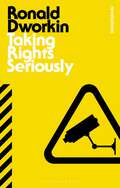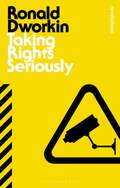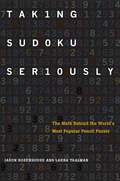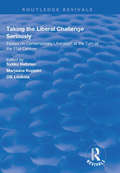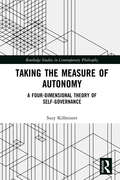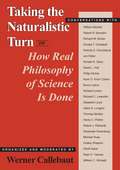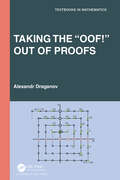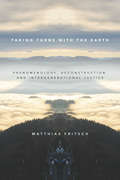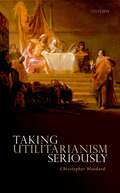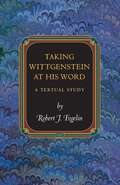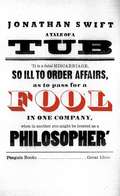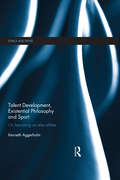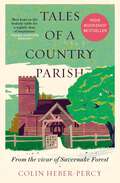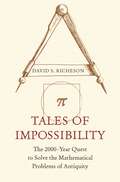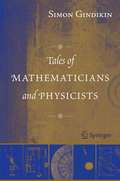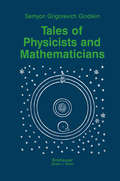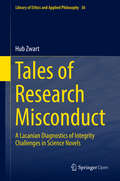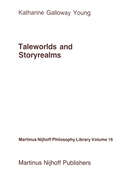- Table View
- List View
Taking Rights Seriously (Bloomsbury Revelations)
by Ronald DworkinA landmark work of political and legal philosophy, Ronald Dworkin's Taking Rights Seriously was acclaimed as a major work on its first publication in 1977 and remains profoundly influential in the 21st century. A forceful statement of liberal principles - championing the legal, moral and political rights of the individual against the state - Dworkin demolishes prevailing utilitarian and legal-positivist approaches to jurisprudence. Developing his own theory of adjudication, he applies this to controversial public issues, from civil disobedience to positive discrimination. Elegantly written and cuttingly insightful, Taking Rights Seriously is one of the most important works of public thought of the last fifty years.
Taking Rights Seriously (Bloomsbury Revelations)
by Ronald DworkinA landmark work of political and legal philosophy, Ronald Dworkin's Taking Rights Seriously was acclaimed as a major work on its first publication in 1977 and remains profoundly influential in the 21st century. A forceful statement of liberal principles - championing the legal, moral and political rights of the individual against the state - Dworkin demolishes prevailing utilitarian and legal-positivist approaches to jurisprudence. Developing his own theory of adjudication, he applies this to controversial public issues, from civil disobedience to positive discrimination. Elegantly written and cuttingly insightful, Taking Rights Seriously is one of the most important works of public thought of the last fifty years.
Taking Sudoku Seriously: The Math Behind the World's Most Popular Pencil Puzzle
by Jason Rosenhouse Laura TaalmanPacked with more than a hundred color illustrations and a wide variety of puzzles and brainteasers, Taking Sudoku Seriously uses this popular craze as the starting point for a fun-filled introduction to higher mathematics. How many Sudoku solution squares are there? What shapes other than three-by-three blocks can serve as acceptable Sudoku regions? What is the fewest number of starting clues a sound Sudoku puzzle can have? Does solving Sudoku require mathematics? Jason Rosenhouse and Laura Taalman show that answering these questions opens the door to a wealth of interesting mathematics. Indeed, they show that Sudoku puzzles and their variants are a gateway into mathematical thinking generally. Among many topics, the authors look at the notion of a Latin square--an object of long-standing interest to mathematicians--of which Sudoku squares are a special case; discuss how one finds interesting Sudoku puzzles; explore the connections between Sudoku, graph theory, and polynomials; and consider Sudoku extremes, including puzzles with the maximal number of vacant regions, with the minimal number of starting clues, and numerous others. The book concludes with a gallery of novel Sudoku variations--just pure solving fun! Most of the puzzles are original to this volume, and all solutions to the puzzles appear in the back of the book or in the text itself. A math book and a puzzle book, Taking Sudoku Seriously will change the way readers look at Sudoku and mathematics, serving both as an introduction to mathematics for puzzle fans and as an exploration of the intricacies of Sudoku for mathematics buffs.
Taking Sudoku Seriously: The Math Behind the World's Most Popular Pencil Puzzle
by Jason Rosenhouse Laura TaalmanPacked with more than a hundred color illustrations and a wide variety of puzzles and brainteasers, Taking Sudoku Seriously uses this popular craze as the starting point for a fun-filled introduction to higher mathematics. How many Sudoku solution squares are there? What shapes other than three-by-three blocks can serve as acceptable Sudoku regions? What is the fewest number of starting clues a sound Sudoku puzzle can have? Does solving Sudoku require mathematics? Jason Rosenhouse and Laura Taalman show that answering these questions opens the door to a wealth of interesting mathematics. Indeed, they show that Sudoku puzzles and their variants are a gateway into mathematical thinking generally. Among many topics, the authors look at the notion of a Latin square--an object of long-standing interest to mathematicians--of which Sudoku squares are a special case; discuss how one finds interesting Sudoku puzzles; explore the connections between Sudoku, graph theory, and polynomials; and consider Sudoku extremes, including puzzles with the maximal number of vacant regions, with the minimal number of starting clues, and numerous others. The book concludes with a gallery of novel Sudoku variations--just pure solving fun! Most of the puzzles are original to this volume, and all solutions to the puzzles appear in the back of the book or in the text itself. A math book and a puzzle book, Taking Sudoku Seriously will change the way readers look at Sudoku and mathematics, serving both as an introduction to mathematics for puzzle fans and as an exploration of the intricacies of Sudoku for mathematics buffs.
Taking the Liberal Challenge Seriously: Essays on Contemporary Liberalism at the Turn of the 21st Century (Routledge Revivals)
by Sirkku Hellsten Marjaana Kopperi Olli LoukolaFirst published in 1997, this collection offers a critical view of modern liberal theory and attempts to present some signposts that could show a way towards a new form of liberal individualism. The first part takes a look at the theoretical aspects of contemporary liberalism. It analyses certain classics whose ideas have once again become central to the new formulation of liberal theory. The second part brings the discussion from theory to practice and to actual policies adopted in liberal Western welfare states. Its main interest is in the economic doctrines which have formed an essential part of classical liberal thought. The third part moves yet another step further in its analysis of contemporary liberal challenges. It concentrates on the problems of the liberal requirement of freedom, neutrality and tolerance.
Taking the Liberal Challenge Seriously: Essays on Contemporary Liberalism at the Turn of the 21st Century (Routledge Revivals)
by Sirkku Hellsten, Marjaana Kopperi and Olli LoukolaFirst published in 1997, this collection offers a critical view of modern liberal theory and attempts to present some signposts that could show a way towards a new form of liberal individualism. The first part takes a look at the theoretical aspects of contemporary liberalism. It analyses certain classics whose ideas have once again become central to the new formulation of liberal theory. The second part brings the discussion from theory to practice and to actual policies adopted in liberal Western welfare states. Its main interest is in the economic doctrines which have formed an essential part of classical liberal thought. The third part moves yet another step further in its analysis of contemporary liberal challenges. It concentrates on the problems of the liberal requirement of freedom, neutrality and tolerance.
Taking the Measure of Autonomy: A Four-Dimensional Theory of Self-Governance (Routledge Studies in Contemporary Philosophy)
by Suzy KillmisterThis book takes a radically different approach to the concept of autonomy. Killmister defends a theory of autonomy that is four-dimensional and constituted by what she calls ‘self-definition,’ ‘self-realisation,’ ‘self-unification,’ and 'self-constitution.' While sufficiently complex to inform a full range of social applications, this four-dimensional theory is nonetheless unified through the simple idea that autonomy can be understood in terms of self-governance. The ‘self’ of self-governance occupies two distinct roles: the role of ‘personal identity’ and the role of ‘practical agency.’ In each of these roles, the self is responsible for both taking on, and then honouring, a wide range of commitments. One of the key benefits of this theory is that it provides a much richer measure not just of how autonomous an agent is, but also the shape—or degree—of her autonomy. Taking the Measure of Autonomy will be of keen interest to professional philosophers and students across social philosophy, political philosophy, ethics, and action theory who are working on autonomy.
Taking the Measure of Autonomy: A Four-Dimensional Theory of Self-Governance (Routledge Studies in Contemporary Philosophy)
by Suzy KillmisterThis book takes a radically different approach to the concept of autonomy. Killmister defends a theory of autonomy that is four-dimensional and constituted by what she calls ‘self-definition,’ ‘self-realisation,’ ‘self-unification,’ and 'self-constitution.' While sufficiently complex to inform a full range of social applications, this four-dimensional theory is nonetheless unified through the simple idea that autonomy can be understood in terms of self-governance. The ‘self’ of self-governance occupies two distinct roles: the role of ‘personal identity’ and the role of ‘practical agency.’ In each of these roles, the self is responsible for both taking on, and then honouring, a wide range of commitments. One of the key benefits of this theory is that it provides a much richer measure not just of how autonomous an agent is, but also the shape—or degree—of her autonomy. Taking the Measure of Autonomy will be of keen interest to professional philosophers and students across social philosophy, political philosophy, ethics, and action theory who are working on autonomy.
Taking the Naturalistic Turn, Or How Real Philosophy of Science Is Done (Science and Its Conceptual Foundations series)
by Werner CallebautPhilosophers of science traditionally have ignored the details of scientific research, and the result has often been theories that lack relevance either to science or to philosophy in general. In this volume, leading philosophers of biology discuss the limitations of this tradition and the advantages of the "naturalistic turn"—the idea that the study of science is itself a scientific enterprise and should be conducted accordingly. This innovative book presents candid, informal debates among scholars who examine the benefits and problems of studying science in the same way that scientists study the natural world. Callebaut achieves the effect of face-to-face engagement through separate interviews with participants. Contributors include William Bechtel, Robert Brandon, Richard M. Burian, Donald T. Campbell, Patricia Churchland, Jon Elster, Ronald N. Giere, David L. Hull, Philip Kitcher, Karin Knorr Cetina, Bruno Latour, Richard Levins, Richard C. Lewontin, Elisabeth Lloyd, Helen Longino, Thomas Nickles, Henry C. Plotkin, Robert J. Richards, Alexander Rosenberg, Michael Ruse, Dudley Shapere, Elliott Sober, Ryan Tweney, and William Wimsatt. "Why can't we have both theoretical ecology and natural histories, lovingly done?"—Philip Kitcher "Don't underestimate the arrogance of philosophers!"—Elisabeth Lloyd
Taking the “Oof!” Out of Proofs (Textbooks in Mathematics)
by Alexandr DraganovThis book introduces readers to the art of doing mathematical proofs. Proofs are the glue that holds mathematics together. They make connections between math concepts and show why things work the way they do. This book teaches the art of proofs using familiar high-school concepts, such as numbers, polynomials, functions, and trigonometry. It retells math as a story, where the next chapter follows from the previous one.Readers will see how various mathematical concepts are tied and will see that mathematics is not a pile of formulas and facts; rather, it has an orderly and beautiful edifice.The author begins with basic rules of logic and then progresses through the topics already familiar to the students: numbers, inequalities, functions, polynomials, exponents, and trigonometric functions. There are also beautiful proofs for conic sections, sequences, and Fibonacci numbers. Each chapter has exercises for the reader.Reviewer Comments:I find the book very impressive. The choice and sequence of topics is excellent, and it is wonderful to have all of these things together in one volume. Theorems are clearly stated, and proofs are accurate. – Michael ComenetzThe thoroughness of the narrative is one of the main strengths of the book. The book provides a perfect illustration of mathematical thinking. Each step of a given derivation is precise and clear. – Julie GershunskayaDraganov’s book stands out from the many competing books. Draganov’s goal is to show that mathematics depends on the notion of proof. Unlike other transition books, he addresses mathematical topics at an accessible level, rather than topics studied later in the university curriculum. – Ken Rosen
Taking the “Oof!” Out of Proofs: A Primer On Mathematical Proofs (Textbooks in Mathematics)
by Alexandr DraganovThis book introduces readers to the art of doing mathematical proofs. Proofs are the glue that holds mathematics together. They make connections between math concepts and show why things work the way they do. This book teaches the art of proofs using familiar high-school concepts, such as numbers, polynomials, functions, and trigonometry. It retells math as a story, where the next chapter follows from the previous one.Readers will see how various mathematical concepts are tied and will see that mathematics is not a pile of formulas and facts; rather, it has an orderly and beautiful edifice.The author begins with basic rules of logic and then progresses through the topics already familiar to the students: numbers, inequalities, functions, polynomials, exponents, and trigonometric functions. There are also beautiful proofs for conic sections, sequences, and Fibonacci numbers. Each chapter has exercises for the reader.Reviewer Comments:I find the book very impressive. The choice and sequence of topics is excellent, and it is wonderful to have all of these things together in one volume. Theorems are clearly stated, and proofs are accurate. – Michael ComenetzThe thoroughness of the narrative is one of the main strengths of the book. The book provides a perfect illustration of mathematical thinking. Each step of a given derivation is precise and clear. – Julie GershunskayaDraganov’s book stands out from the many competing books. Draganov’s goal is to show that mathematics depends on the notion of proof. Unlike other transition books, he addresses mathematical topics at an accessible level, rather than topics studied later in the university curriculum. – Ken Rosen
Taking Turns with the Earth: Phenomenology, Deconstruction, and Intergenerational Justice
by Matthias FritschThe environmental crisis, one of the great challenges of our time, tends to disenfranchise those who come after us. Arguing that as temporary inhabitants of the earth, we cannot be indifferent to future generations, this book draws on the resources of phenomenology and poststructuralism to help us conceive of moral relations in connection with human temporality. Demonstrating that moral and political normativity emerge with generational time, the time of birth and death, this book proposes two related models of intergenerational and environmental justice. The first entails a form of indirect reciprocity, in which we owe future people both because of their needs and interests and because we ourselves have been the beneficiaries of peoples past; the second posits a generational taking of turns that Matthias Fritsch applies to both our institutions and our natural environment, in other words, to the earth as a whole. Offering new readings of key philosophers, and emphasizing the work of Emmanuel Levinas and Jacques Derrida in particular, Taking Turns with the Earth disrupts human-centered notions of terrestrial appropriation and sharing to give us a new continental philosophical account of future-oriented justice.
Taking Utilitarianism Seriously
by Christopher WoodardUtilitarianism is the idea that ethics is ultimately about what makes people's lives go better. While utilitarian ideas remain highly influential in politics and culture, they are subject to many well-developed philosophical criticisms, such as the claim that utilitarianism requires too much of us and the view that it does not respect individuals' rights. The theory is widely thought by philosophers to be the least plausible form of consequentialism, hampered by its excessive simplicity. In Taking Utilitarianism Seriously, Christopher Woodard argues that it is not defeated by the standard objections. He presents a new and rich version of utilitarianism that can answer all six commons objections plausibly and, in doing so, launches a state-of-the-art defence of the utilitarian tradition, which has greater resources than its critics have often assumed. Far from being excessively simple, utilitarianism is able to account for much of the complexity and nuance of everyday ethical thought. And rather than being quickly dismissed, utilitarian approaches to moral and political philosophy are due for renewed development and discussion.
Taking Utilitarianism Seriously
by Christopher WoodardUtilitarianism is the idea that ethics is ultimately about what makes people's lives go better. While utilitarian ideas remain highly influential in politics and culture, they are subject to many well-developed philosophical criticisms, such as the claim that utilitarianism requires too much of us and the view that it does not respect individuals' rights. The theory is widely thought by philosophers to be the least plausible form of consequentialism, hampered by its excessive simplicity. In Taking Utilitarianism Seriously, Christopher Woodard argues that it is not defeated by the standard objections. He presents a new and rich version of utilitarianism that can answer all six commons objections plausibly and, in doing so, launches a state-of-the-art defence of the utilitarian tradition, which has greater resources than its critics have often assumed. Far from being excessively simple, utilitarianism is able to account for much of the complexity and nuance of everyday ethical thought. And rather than being quickly dismissed, utilitarian approaches to moral and political philosophy are due for renewed development and discussion.
Taking Wittgenstein at His Word: A Textual Study
by Robert J. FogelinTaking Wittgenstein at His Word is an experiment in reading organized around a central question: What kind of interpretation of Wittgenstein's later philosophy emerges if we adhere strictly to his claims that he is not in the business of presenting and defending philosophical theses and that his only aim is to expose persistent conceptual misunderstandings that lead to deep philosophical perplexities? Robert Fogelin draws out the therapeutic aspects of Wittgenstein's later work by closely examining his account of rule-following and how he applies the idea in the philosophy of mathematics. The first of the book's two parts focuses on rule-following, Wittgenstein's "paradox of interpretation," and his naturalistic response to this paradox, all of which are persistent and crucial features of his later philosophy. Fogelin offers a corrective to the frequent misunderstanding that the paradox of interpretation is a paradox about meaning, and he emphasizes the importance of Wittgenstein's often undervalued appeals to natural responses. The second half of the book examines how Wittgenstein applies his reflections on rule-following to the status of mathematical propositions, proofs, and objects, leading to remarkable, demystifying results. Taking Wittgenstein at His Word shows that what Wittgenstein claims to be doing and what he actually does are much closer than is often recognized. In doing so, the book underscores fundamental--but frequently underappreciated--insights about Wittgenstein's later philosophy.
Taking Wittgenstein at His Word: A Textual Study (Princeton Monographs in Philosophy #29)
by Robert J. FogelinTaking Wittgenstein at His Word is an experiment in reading organized around a central question: What kind of interpretation of Wittgenstein's later philosophy emerges if we adhere strictly to his claims that he is not in the business of presenting and defending philosophical theses and that his only aim is to expose persistent conceptual misunderstandings that lead to deep philosophical perplexities? Robert Fogelin draws out the therapeutic aspects of Wittgenstein's later work by closely examining his account of rule-following and how he applies the idea in the philosophy of mathematics. The first of the book's two parts focuses on rule-following, Wittgenstein's "paradox of interpretation," and his naturalistic response to this paradox, all of which are persistent and crucial features of his later philosophy. Fogelin offers a corrective to the frequent misunderstanding that the paradox of interpretation is a paradox about meaning, and he emphasizes the importance of Wittgenstein's often undervalued appeals to natural responses. The second half of the book examines how Wittgenstein applies his reflections on rule-following to the status of mathematical propositions, proofs, and objects, leading to remarkable, demystifying results. Taking Wittgenstein at His Word shows that what Wittgenstein claims to be doing and what he actually does are much closer than is often recognized. In doing so, the book underscores fundamental--but frequently underappreciated--insights about Wittgenstein's later philosophy.
A Tale of a Tub: The Battle Of The Books (Mobi Classics Series)
by Jonathan SwiftThroughout history, some books have changed the world. They have transformed the way we see ourselves - and each other. They have inspired debate, dissent, war and revolution. They have enlightened, outraged, provoked and comforted. They have enriched lives - and destroyed them. Now Penguin brings you the works of the great thinkers, pioneers, radicals and visionaries whose ideas shook civilization, and helped make us who we are.
Talent Development, Existential Philosophy and Sport: On Becoming an Elite Athlete (Ethics and Sport)
by Kenneth Aggerholm'Why don’t young athletes in sport just quit?’ Starting with this question and drawing on existential philosophy, phenomenology and hermeneutics, Talent Development, Existential Philosophy and Sport seeks a deeper understanding of the experience of being a talented young sportsperson striving to become an elite athlete. As an alternative to conventional approaches to talent development governed by a worldview of instrumental rationality, the book introduces key ideas from educational philosophy to describe talent development through the concept of elite-Bildung. It pursues an existential understanding of developing in sport as a process of freedom, self-transcendence, striving for excellence and building up habits. The book highlights a range of ambiguous and intriguing existential phenomena – most prominently wonder, question, expression, humour and repetition – and reveals an existential layer of meaning within talent development in sport, which can facilitate the process of becoming an elite athlete and give young athletes a number of reasons not to quit. By deepening our understanding of performance and development in sport, and the process of becoming an elite player, this book is important reading for any serious student or researcher working in the philosophy of sport, sports coaching, sports development, sport psychology or applied sport science.
Talent Development, Existential Philosophy and Sport: On Becoming an Elite Athlete (Ethics and Sport)
by Kenneth Aggerholm'Why don’t young athletes in sport just quit?’ Starting with this question and drawing on existential philosophy, phenomenology and hermeneutics, Talent Development, Existential Philosophy and Sport seeks a deeper understanding of the experience of being a talented young sportsperson striving to become an elite athlete. As an alternative to conventional approaches to talent development governed by a worldview of instrumental rationality, the book introduces key ideas from educational philosophy to describe talent development through the concept of elite-Bildung. It pursues an existential understanding of developing in sport as a process of freedom, self-transcendence, striving for excellence and building up habits. The book highlights a range of ambiguous and intriguing existential phenomena – most prominently wonder, question, expression, humour and repetition – and reveals an existential layer of meaning within talent development in sport, which can facilitate the process of becoming an elite athlete and give young athletes a number of reasons not to quit. By deepening our understanding of performance and development in sport, and the process of becoming an elite player, this book is important reading for any serious student or researcher working in the philosophy of sport, sports coaching, sports development, sport psychology or applied sport science.
Tales of a Country Parish: From the vicar of Savernake Forest
by Colin Heber-Percy'A delightful book from a gentle, generous spirit.' - SIMON RUSSELL BEALE'Philosophical speculation, country lore, rock music, spiritual exploration, erudite and beautifully written, this collection of reflections and meditations is a surprise and a delight. The kind of shot in the arm the Church of England badly needs - and is so rarely to be found.' - SALLEY VICKERSDuring the unprecedented circumstances of Spring 2020, Colin Heber Percy began writing a daily newsletter of reflections and uplifting stories to stay in touch with his parishioners. Word spread, and soon his bulletins were being eagerly consumed by readers around the country and beyond.In this thought-provoking and invigorating book, Heber-Percy draws upon a kaleidoscopic knowledge of nature, philosophy, poetry and music, as well as religious writings, and interlaces them with amusing and touching vignettes from his Wiltshire parish.As he follows the changing seasons, Heber-Percy moves from the seemingly small and mundane to ponder big life questions - can you find heaven in a Londis shop, why is the Bible not like the Highway Code, what on earth we are all doing here - while gently offering up wisdom and sustenance for all, regardless of faith and creed.
Tales of Impossibility: The 2000-Year Quest to Solve the Mathematical Problems of Antiquity
by David S. RichesonA comprehensive look at four of the most famous problems in mathematicsTales of Impossibility recounts the intriguing story of the renowned problems of antiquity, four of the most famous and studied questions in the history of mathematics. First posed by the ancient Greeks, these compass and straightedge problems—squaring the circle, trisecting an angle, doubling the cube, and inscribing regular polygons in a circle—have served as ever-present muses for mathematicians for more than two millennia. David Richeson follows the trail of these problems to show that ultimately their proofs—demonstrating the impossibility of solving them using only a compass and straightedge—depended on and resulted in the growth of mathematics.Richeson investigates how celebrated luminaries, including Euclid, Archimedes, Viète, Descartes, Newton, and Gauss, labored to understand these problems and how many major mathematical discoveries were related to their explorations. Although the problems were based in geometry, their resolutions were not, and had to wait until the nineteenth century, when mathematicians had developed the theory of real and complex numbers, analytic geometry, algebra, and calculus. Pierre Wantzel, a little-known mathematician, and Ferdinand von Lindemann, through his work on pi, finally determined the problems were impossible to solve. Along the way, Richeson provides entertaining anecdotes connected to the problems, such as how the Indiana state legislature passed a bill setting an incorrect value for pi and how Leonardo da Vinci made elegant contributions in his own study of these problems.Taking readers from the classical period to the present, Tales of Impossibility chronicles how four unsolvable problems have captivated mathematical thinking for centuries.
Tales of Mathematicians and Physicists
by Simon GindikinThis revised and greatly expanded second edition of the Russian text contains a wealth of new information about the lives and accomplishments of more than a dozen scientists throughout five centuries of history: from the first steps in algebra up to new achievements in geometry in connection with physics. The heroes of the book are renowned figures from early eras, as well some scientists of last century. A unique mixture of mathematics, physics, and history, this volume provides biographical glimpses of scientists and their contributions in the context of the social and political background of their times.
Tales of Physicists and Mathematicians
by Simon GindikinThis revised and greatly expanded edition of the Russian classic contains a wealth of new information about the lives of many great mathematicians and scientists, past and present. Written by a distinguished mathematician and featuring a unique mix of mathematics, physics, and history, this text combines original source material and provides careful explanations for some of the most significant discoveries in mathematics and physics. What emerges are intriguing, multifaceted biographies that will interest readers at all levels.
Tales of Research Misconduct: A Lacanian Diagnostics of Integrity Challenges in Science Novels (Library of Ethics and Applied Philosophy #36)
by Hub ZwartThis monograph contributes to the scientific misconduct debate from an oblique perspective, by analysing seven novels devoted to this issue, namely: Arrowsmith by Sinclair Lewis (1925), The affair by C.P. Snow (1960), Cantor’s Dilemma by Carl Djerassi (1989), Perlmann’s Silence by Pascal Mercier (1995), Intuition by Allegra Goodman (2006), Solar by Ian McEwan (2010) and Derailment by Diederik Stapel (2012). Scientific misconduct, i.e. fabrication, falsification, plagiarism, but also other questionable research practices, have become a focus of concern for academic communities worldwide, but also for managers, funders and publishers of research. The aforementioned novels offer intriguing windows into integrity challenges emerging in contemporary research practices. They are analysed from a continental philosophical perspective, providing a stage where various voices, positions and modes of discourse are mutually exposed to one another, so that they critically address and question one another. They force us to start from the admission that we do not really know what misconduct is. Subsequently, by providing case histories of misconduct, they address integrity challenges not only in terms of individual deviance but also in terms of systemic crisis, due to current transformations in the ways in which knowledge is produced. Rather than functioning as moral vignettes, the author argues that misconduct novels challenge us to reconsider some of the basic conceptual building blocks of integrity discourse.Except where otherwise noted, this book is licensed under a Creative Commons Attribution 4.0 International License. To view a copy of this license, visit http://creativecommons.org/licenses/by/4.0/.
Taleworlds and Storyrealms: The Phenomenology of Narrative (Martinus Nijhoff Philosophy Library #16)
by K. YoungBeginning is the hardest ITPment, not because openers are all that scarce but because you're blowing into, cracking a universe. l Maurice Natanson q;>enings are already directed toward closings. The first question in presenting a body of work is where to cut in. This is an especially difficult question since the cut-in provides a perspecti ve on what follows. A cut is an angle of entry. Wherever I enter, from there, a realm unfolds itself. In that sense, my angle of entry is my point of view. A realm cut into has an orientation. It evidences a hierarchy of importance, relevance, accessability, value, or logic. Its content is no longer neutral and equivalent. From my perspective, the realm is not only differentiated in sUbstance but differential in significance. There is a relation between angles and attitudes. Where I look from is tied up with how I see. The first cut opens out into a frame of reference. What count as lines of evidence in that realm materialize along with its background expectancies, its assumptions, concentrations, and confusions, its coslTPlogy, quirks, and enchantments. Hence, once I am corrunitted to a perspective, I am implicated in a methodology, one possessed of puzzles of a certain shape, ITPving toward solutions wi thin its orthodoxy. Openings are directed toward closings. Another cut would open onto another realm. The realm of events I cut into is a Taleworld, inhabited by characters acting in their own space and time.
